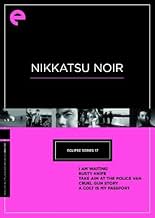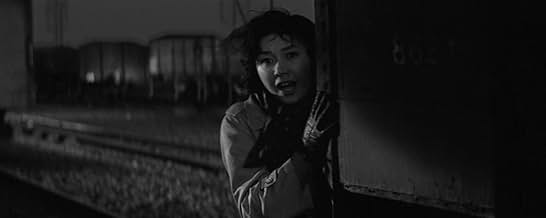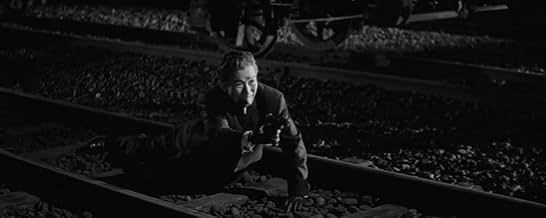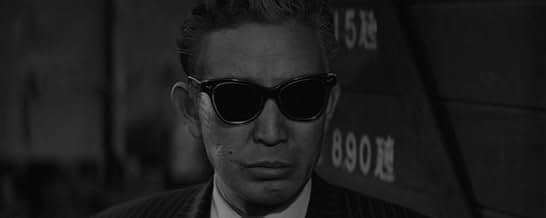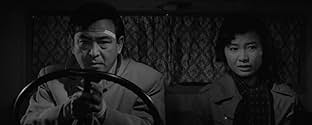Mire na viatura
Título original: 'Jûsangô taihisen' yori: Sono gosôsha o nerae
AVALIAÇÃO DA IMDb
6,6/10
1,4 mil
SUA AVALIAÇÃO
Adicionar um enredo no seu idiomaA prison truck is assaulted and the two convicts inside are murdered. The prison guard on duty gets suspended for negligence and takes it upon himself to track down the killers.A prison truck is assaulted and the two convicts inside are murdered. The prison guard on duty gets suspended for negligence and takes it upon himself to track down the killers.A prison truck is assaulted and the two convicts inside are murdered. The prison guard on duty gets suspended for negligence and takes it upon himself to track down the killers.
- Direção
- Roteiristas
- Artistas
- Direção
- Roteiristas
- Elenco e equipe completos
- Produção, bilheteria e muito mais no IMDbPro
Avaliações em destaque
Film 3/5 in the Nikkatsu Noir boxset I'm working through, and I'd rank this behind Rusty Knife (film 2/5), but ahead of I Am Waiting (film 1/5).
I'll give it this: Take Aim at the Police Van has a great title and a great opening- both work well to get you hooked early to the simple premise (prison guard is partially blamed for deaths that weren't his fault, so he goes looking for the real killers himself) that soon balloons out and gets very complicated.
While some of the complexity and mystery is intentional, given the main character doesn't really know what's going on much of the time, I think it may have left the audience in the dark just a little too much. You could say that about a lot of classic noir, though- I think it's The Maltese Falcon where the writer even admitted he didn't really understand 100% of the plot.
(EDIT: legend actually goes that it was The Big Sleep where the screenwriters were confused by what they were writing. Do remember Maltese Falcon also having a confusing plot, for what it's worth)
But in any event, it stays entertaining because of the fast (if almost a little too quick) pace, the stylish direction, and some exciting sequences. Plus the mystery is a pretty decent one.
It all makes for an overall solid watch.
I'll give it this: Take Aim at the Police Van has a great title and a great opening- both work well to get you hooked early to the simple premise (prison guard is partially blamed for deaths that weren't his fault, so he goes looking for the real killers himself) that soon balloons out and gets very complicated.
While some of the complexity and mystery is intentional, given the main character doesn't really know what's going on much of the time, I think it may have left the audience in the dark just a little too much. You could say that about a lot of classic noir, though- I think it's The Maltese Falcon where the writer even admitted he didn't really understand 100% of the plot.
(EDIT: legend actually goes that it was The Big Sleep where the screenwriters were confused by what they were writing. Do remember Maltese Falcon also having a confusing plot, for what it's worth)
But in any event, it stays entertaining because of the fast (if almost a little too quick) pace, the stylish direction, and some exciting sequences. Plus the mystery is a pretty decent one.
It all makes for an overall solid watch.
Take Aim at the Police Van, originally known as Jûsangô taihisen' yori: Sono gosôsha o nerae, is a Japanese film noir that unfolds as an investigative thriller through seventy-nine minutes. The movie was made by renowned director Seijun Suzuki who had become a regular choice for Nikkatsu Studios by the early sixties before experimenting wildly with visual effects and being kicked out in 1967. Mizushima Michitaro incarnates the film's sincere protagonist and his grounded depiction provides much depth to the film while his acting experience of thirty-five years makes for a charismatic screen presence throughout. He is paired up with rising star Watanabe Misako who shines as charismatic feminist with remarkable courage, smart decisions and dedicated independence.
In this particular film, Mizushima Michitaro plays a guard who is supposed to bring a group of prisoners to a new location in the middle of the night. The van gets ambushed and two prisoners are brutally murdered. The guard is suspended for six months and decides to investigate the motive behind those assassinations. He starts by observing a third prisoner who survived the ordeal who seems to have ties to a shady call girl agency. Said agency is led by an enigmatic young woman whose father is in jail. She starts investigating the mysterious case as well as she believes a mysterious concurrent called Akiba might be the mastermind behind the crimes. The disgraced guard and the ambitious businesswoman team up in order to make justice prevail despite opposition from arrogant police officers and nagging business partners alike.
This film noir convinces on several levels. The movie oozes with sinister atmosphere thanks to excellent lighting techniques, gloomy camera work and appropriate settings on isolated roads in the middle of the night or in decaying industrial areas on the outskirts of rapidly developing towns. The acting performances are great as Mizushima Michitaro convinces as unusually old lead actor while Watanabe Misako is ahead of her time by portraying a strong feminist femme fatale. The film's finale is particularly intense and will leave a lasting emotional impression upon genre fans, thus bringing the movie full circle as it reconnects to its gripping overture.
However, this film is also weaker than many other Japanese films noirs that saw the light of day in the late fifties and early sixties. Despite its short running time, the movie has noticeable lengths and especially its middle section drags on for far too long. The script is thin and takes much time to unfold between the intense opening ten minutes and the conciliatory final ten minutes. The film's side characters remain shallow and the supporting actors and actresses aren't given any chance to showcase their talents significantly.
At the end of the day, the coolest thing about Take Aim at the Police Van, originally known as Jûsangô taihisen' yori: Sono gosôsha o nerae, might actually be its catchy title. Its gloomy atmosphere, excellent lead actress and lead actor as well as its gripping opening and closing scene keep this film from drowning in mediocrity. The middle section's exhausting lengths, weak script and shallow side characters incarnated by a cast that fails to stand out reduce this movie to a film noir that only just qualifies as good average movie that tends to be slightly overrated in hindsight. My sincere recommendation is to watch several other Japanese genre films of the same era instead while this particular film here is only of interest for adamant fans of the lead actor, the lead actress and the controversial director in particular.
In this particular film, Mizushima Michitaro plays a guard who is supposed to bring a group of prisoners to a new location in the middle of the night. The van gets ambushed and two prisoners are brutally murdered. The guard is suspended for six months and decides to investigate the motive behind those assassinations. He starts by observing a third prisoner who survived the ordeal who seems to have ties to a shady call girl agency. Said agency is led by an enigmatic young woman whose father is in jail. She starts investigating the mysterious case as well as she believes a mysterious concurrent called Akiba might be the mastermind behind the crimes. The disgraced guard and the ambitious businesswoman team up in order to make justice prevail despite opposition from arrogant police officers and nagging business partners alike.
This film noir convinces on several levels. The movie oozes with sinister atmosphere thanks to excellent lighting techniques, gloomy camera work and appropriate settings on isolated roads in the middle of the night or in decaying industrial areas on the outskirts of rapidly developing towns. The acting performances are great as Mizushima Michitaro convinces as unusually old lead actor while Watanabe Misako is ahead of her time by portraying a strong feminist femme fatale. The film's finale is particularly intense and will leave a lasting emotional impression upon genre fans, thus bringing the movie full circle as it reconnects to its gripping overture.
However, this film is also weaker than many other Japanese films noirs that saw the light of day in the late fifties and early sixties. Despite its short running time, the movie has noticeable lengths and especially its middle section drags on for far too long. The script is thin and takes much time to unfold between the intense opening ten minutes and the conciliatory final ten minutes. The film's side characters remain shallow and the supporting actors and actresses aren't given any chance to showcase their talents significantly.
At the end of the day, the coolest thing about Take Aim at the Police Van, originally known as Jûsangô taihisen' yori: Sono gosôsha o nerae, might actually be its catchy title. Its gloomy atmosphere, excellent lead actress and lead actor as well as its gripping opening and closing scene keep this film from drowning in mediocrity. The middle section's exhausting lengths, weak script and shallow side characters incarnated by a cast that fails to stand out reduce this movie to a film noir that only just qualifies as good average movie that tends to be slightly overrated in hindsight. My sincere recommendation is to watch several other Japanese genre films of the same era instead while this particular film here is only of interest for adamant fans of the lead actor, the lead actress and the controversial director in particular.
Great opening, but got messy quickly, and ultimately was an unsatisfying 79 minutes. The frumpled lead character (48 year old Michitaro Mizushima) reminded me a little of Glenn Ford in The Big Heat and the befuddling, often nonsensical plot reminded me of The Big Sleep, but Seijun Suzuki's work lacks the star power and atmosphere of those films. Questions piled up for me as I watched, and not just about the sequence of events from one scene to the next, but about basic character motivations for pretty much all of these people. The grand reveal of Akiba near the end was silly and a letdown too.
I never began actively disliking it though, because I never really knew what Suzuki was going to put on the screen next. There's a topless stripper shot in the chest with an arrow, and a James Bond like escape from an attempted execution (when of course a simple bullet would have made so much more sense). One of the mysterious young women being tracked down loves American rock 'n' roll, and has a gang of teenage friends pile out of car to protect her. There are several murders, but the main character believes in the goodness in people, and improbably the beautiful young femme fatale (Misako Watanabe) softens and falls in love with him. It's an absurdity set to a jazzy soundtrack and doesn't really work, but somehow held my interest. You can do better though.
I never began actively disliking it though, because I never really knew what Suzuki was going to put on the screen next. There's a topless stripper shot in the chest with an arrow, and a James Bond like escape from an attempted execution (when of course a simple bullet would have made so much more sense). One of the mysterious young women being tracked down loves American rock 'n' roll, and has a gang of teenage friends pile out of car to protect her. There are several murders, but the main character believes in the goodness in people, and improbably the beautiful young femme fatale (Misako Watanabe) softens and falls in love with him. It's an absurdity set to a jazzy soundtrack and doesn't really work, but somehow held my interest. You can do better though.
Twisty detective flick from the director of Branded to Kill. After the police van of which he was in charge is ambushed by a sniper, prison guard Michitaro Mizushima (the star of the earlier Suzuki film Underworld Beauty) is suspended from his job. Upset over his failure to protect those under his charge, Mizushima conducts his own investigation. This is an extremely convoluted mystery - a fact to which the film cops. Suzuki's master direction keeps it moving. The opening and closing sequences in particular are brilliant. I just wish I knew what the Hell was going on! I was very tired while watching it, I should say.
This is one violent (not in gore as it is brute force intensity), gritty film-noir (part of the "Nikkatsu Noir" set from Eclipse/Criterion) that has a helluva hook - a prison van carrying a couple of peeps is driving at night and two criminals knock a truck in its path to stop the van and then shoot to kill. In the aftermath, one of the guards, Tamon (Mizushima, strapping and no BS male star for Japan if I ever saw one, a bit like a Japanese Mitchum or Glenn Ford), takes it on himself to investigate who was behind it, and it leads him into an 'Agency' that pimps out young women among other nefarious crimes (and what does Tsunaka Ando, played by Shiraki, have to do with it all, or does she even know?)
What makes Seizuki's direction so palpable and involving is how he manages to find some stylistic flourishes while keeping this tight 79 minute story moving; there's this one superbly edited bit where Tamon is walking down a street and Seizuki cuts from him and his grim-determined profile and these four young ladies singing along to a pop song on a jukebox. You think he's recognized the young woman he's been after, he followed her and lost her in a previous scene (those darn graveyards will get ya), but it's not till just a slight beat after he goes by her that he does a double take and recognizes her (and her him) and as he lunges for her she gives a look and the other girls pounce on him. It's extremely clever direction placing us in suspense we aren't even sure will come about, and then it ends on a tussle that is more funny than thrilling (and that's good sometimes!)
Take Aim at the Police Van (one of my favorite titles of all time for the record) doesn't have the most original supporting characters, mostly low life thugs and pissants who may only best Tamon because they're a step ahead of him, and even Shiraki is mostly there to get tense when questioned and then fold pretty quickly thereafter. But the mystery is drawn out without any extra fat on the spine, when characters (mostly Tamon but eventually some others in his orbit) are in danger and are either trapped or fending for their lives it feels like anything can happen, and Seizuki understands widescreen can be used formidably for creating spaces and tension and also for an impactful, once or twice nearly iconic close up (like the sunglasses when we get to see them on the man).
Maybe it is "minor" when compared to Branded to Kill, but that's a tall bar to clear and this is perfectly entertaining B moviemaking all on its own - with an ironic twist ending, but one that means to end more on a surprising emotional beat than a simple "gotcha.
What makes Seizuki's direction so palpable and involving is how he manages to find some stylistic flourishes while keeping this tight 79 minute story moving; there's this one superbly edited bit where Tamon is walking down a street and Seizuki cuts from him and his grim-determined profile and these four young ladies singing along to a pop song on a jukebox. You think he's recognized the young woman he's been after, he followed her and lost her in a previous scene (those darn graveyards will get ya), but it's not till just a slight beat after he goes by her that he does a double take and recognizes her (and her him) and as he lunges for her she gives a look and the other girls pounce on him. It's extremely clever direction placing us in suspense we aren't even sure will come about, and then it ends on a tussle that is more funny than thrilling (and that's good sometimes!)
Take Aim at the Police Van (one of my favorite titles of all time for the record) doesn't have the most original supporting characters, mostly low life thugs and pissants who may only best Tamon because they're a step ahead of him, and even Shiraki is mostly there to get tense when questioned and then fold pretty quickly thereafter. But the mystery is drawn out without any extra fat on the spine, when characters (mostly Tamon but eventually some others in his orbit) are in danger and are either trapped or fending for their lives it feels like anything can happen, and Seizuki understands widescreen can be used formidably for creating spaces and tension and also for an impactful, once or twice nearly iconic close up (like the sunglasses when we get to see them on the man).
Maybe it is "minor" when compared to Branded to Kill, but that's a tall bar to clear and this is perfectly entertaining B moviemaking all on its own - with an ironic twist ending, but one that means to end more on a surprising emotional beat than a simple "gotcha.
Você sabia?
- CuriosidadesA trail of gasoline poured on the ground as depicted here, would burn at only about three miles per hour, or about the pace of a brisk walk. This velocity was tested on Trail Blazers (2007).
- Erros de gravaçãoIn the opening scenes, the prisoner's handcuffs are so loose that he could easily slip his hand through.
- ConexõesFeatured in Best in Action: 1960 (2018)
Principais escolhas
Faça login para avaliar e ver a lista de recomendações personalizadas
Detalhes
- Data de lançamento
- País de origem
- Idioma
- Também conhecido como
- Take Aim at the Police Van
- Empresa de produção
- Consulte mais créditos da empresa na IMDbPro
- Tempo de duração
- 1 h 19 min(79 min)
- Cor
- Proporção
- 2.35 : 1
Contribua para esta página
Sugerir uma alteração ou adicionar conteúdo ausente

